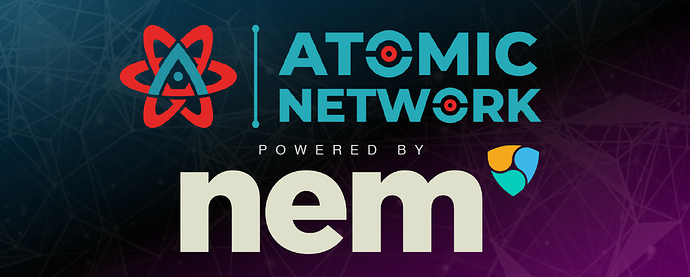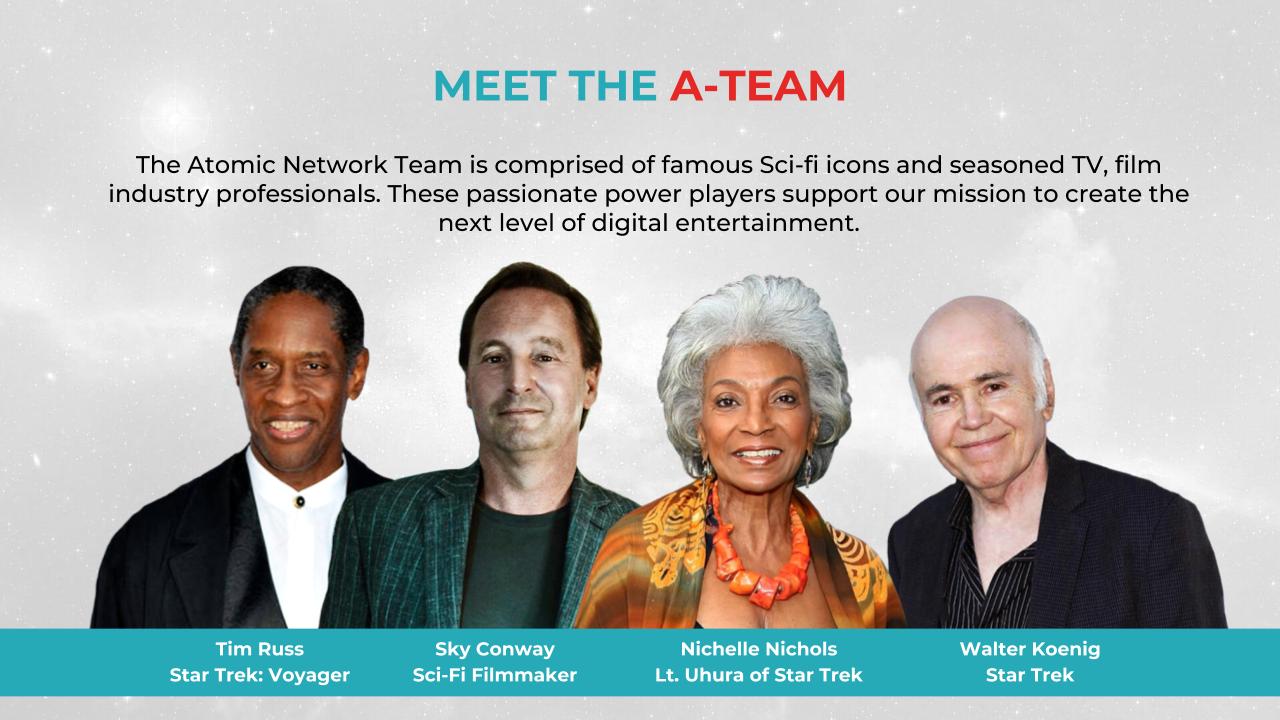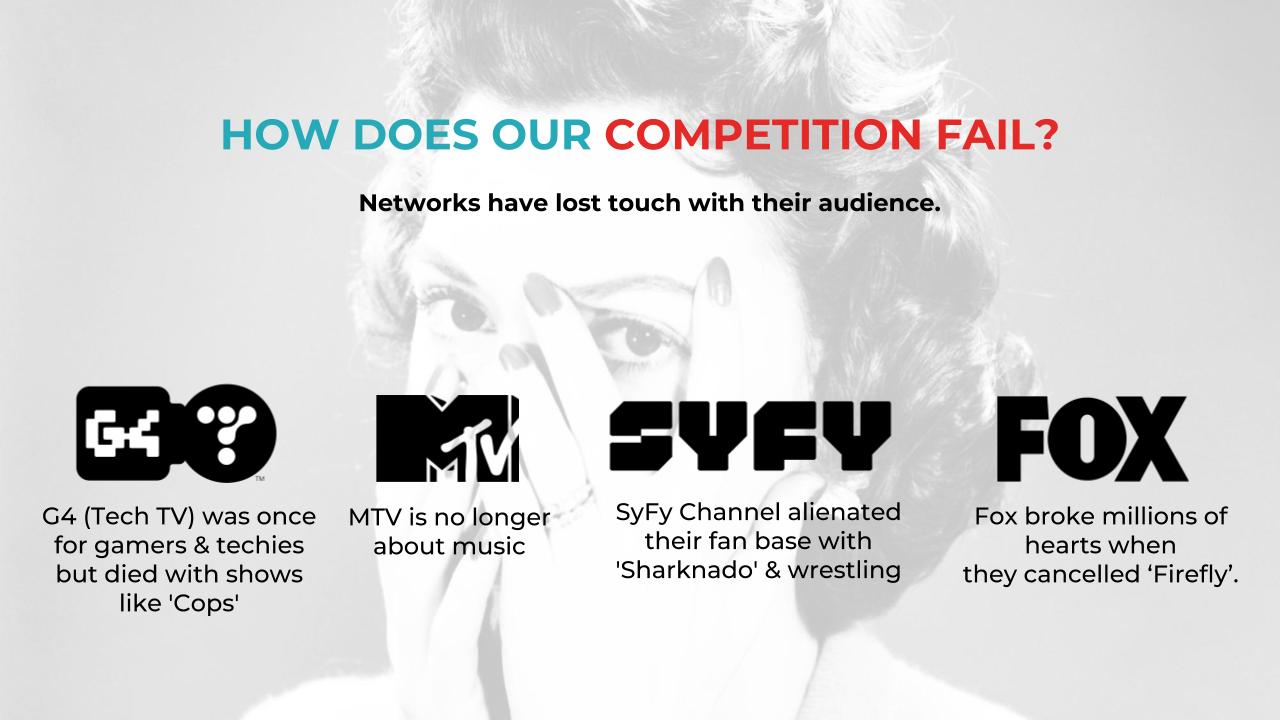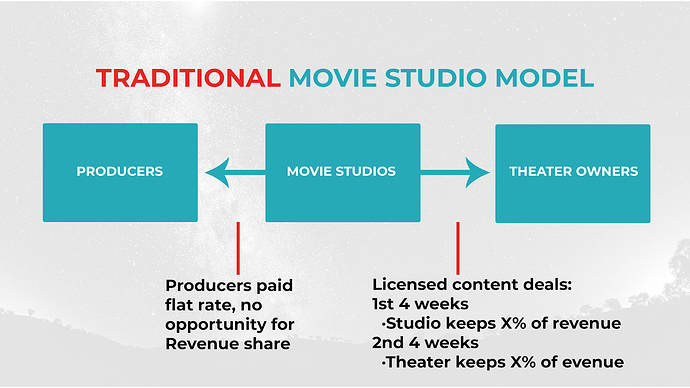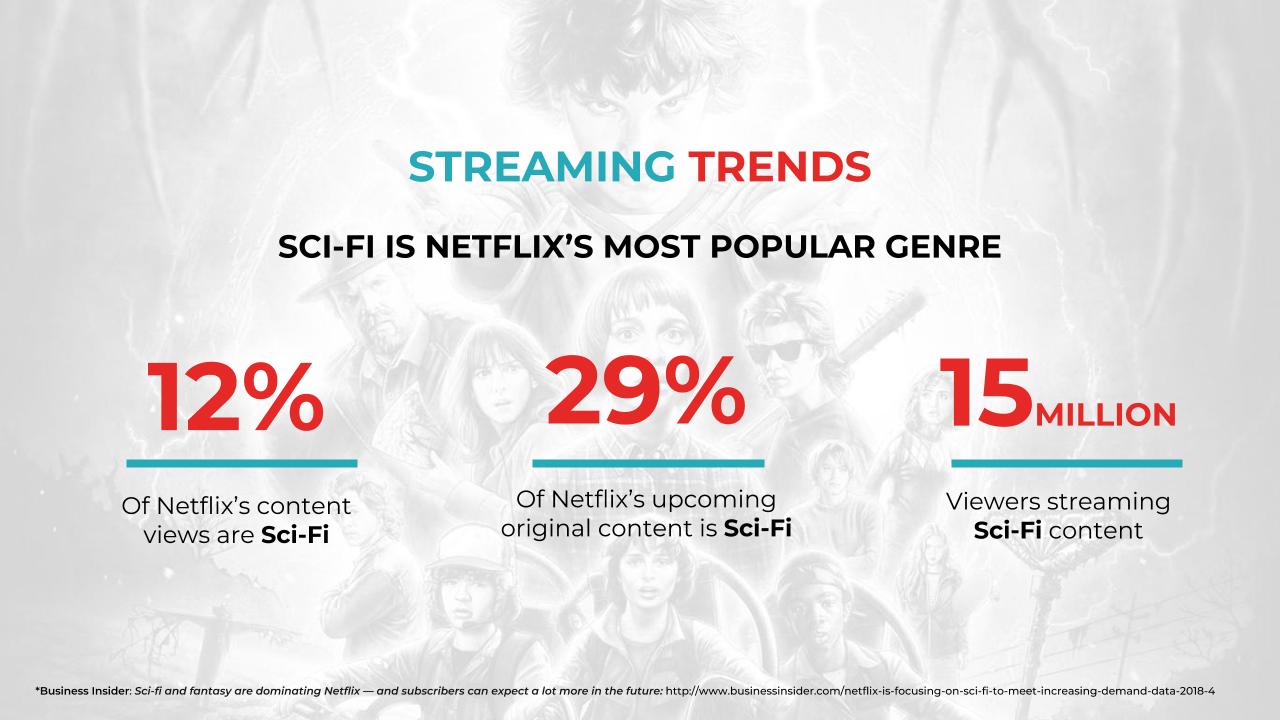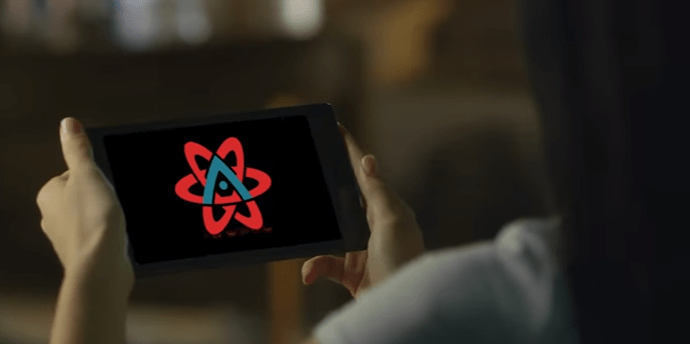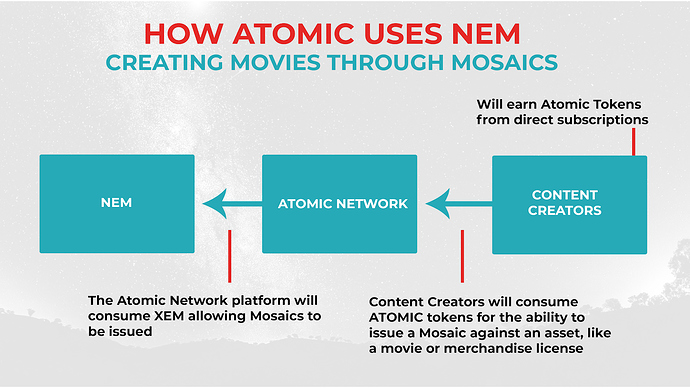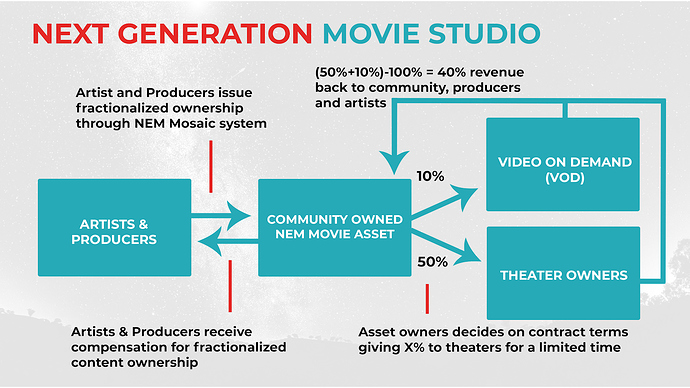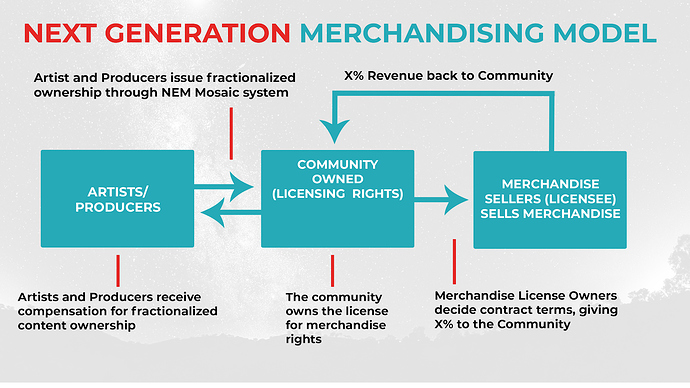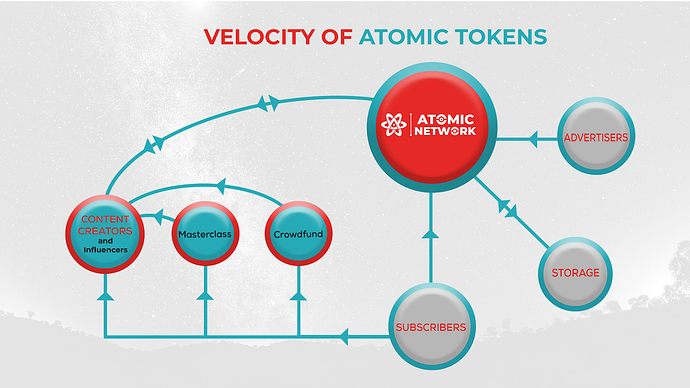Atomic Network is an interactive, blockchain powered, community-driven, streaming entertainment network. The Atomic Network platform will enable on-demand TV and movie streaming experiences for its global audience. Atomic Network will contain a publishing platform and will be based on the distributed architecture of NEM.
The Atomic Network team has a proven track record with over $1.3 million in successful crowdfunded Sci-Fi TV shows and movies on Kickstarter and Indiegogo. This includes such titles as Star Trek: Renegades and Star Trek: Of Gods and Men.
I’m an early evangelist of Cryptocurrencies and was mentored by Gene Roddenberry (the creator of Star Trek) which, helped inspire the start of my filmmaking career.
From previous crowdfunding projects, the team has amassed over 150,000 active fans in their Star Trek Renegades Facebook communities and over 4 million views of Star Trek Renegades.
Below is a proposal to the NEM community is to build the Atomic Network Platform. The details below will address the problem we’re solving, market and competitive analysis as well as the core platform, revenue models, and technical milestones.
Thanks for your time and consideration,
~Sky Conway
Filmmaker, Cryptoenthusiast
Founder of Atomic Network
Table of Contents
1. Origin Story
2. Solving a Big Problem
3. Industry Overview
4. Condensed Marketing Analysis & Strategy
5. Competitive analysis
6. Meet Atomic Core - The Community
a. User Types
b. Community Components
7. NEM and its Blockchain Technology
8. Business Development and Marketing
9. Revenue Models
10. Atomic Network Team
a. Core Production Staff
b. Marketing, Design and Wand Web Development Staff
c. Interim Business Development, Blockchain Development, Management and Operations
11. Technical Milestones
a. Expected Completion Timelines
b. Expected Milestone Costs
1. Origin Story
Sky Conway’s roots go back to his grandfather’s enterprise making the first rubber toys for Disney. Recalling his grandfather’s good fortune, he decided to follow in his footsteps and create replicas of iconic artifacts from Sci-Fi movies and TV shows.
This is eventually how he met George Lucas. George told Sky, “Always own your own content!” George spent the better part of 15+ years making enough money by selling merchandise to buy back the rights to the original Star Wars from Fox.
Sky was a student of Gene Roddenberry (Creator of Star Trek). They spent most of their time together in Gene’s final years during the early 1990s. Gene saw the Internet peeking its head over the horizon (much like we see Crypto today) and told Sky there would be a time where we could watch media on the internet.
Fast forward 29 years, and here we are. The content streaming platforms of today have proven the concept Gene envisioned.
Since his precious final moments with Gene, Sky met such Star Trek legends as Tim Russ (Star Trek Voyager), Walter Koenig (Original Star Trek) and Nichelle Nichols (Original Star Trek) who he brought on founding Atomic Network team members.
Now, Sky Conway’s vision of a community owned and user controlled Atomic Network is going to evolve streaming entertainment with Blockchain technologies help.
2. Solving a Big Problem
Audiences are in grave need of new, community-driven ways to consume, fund and produce content. Publishers are focused on the bottom line at the expense of audiences (particularly if shows don’t hit a desired level of viewers).
There’s a new trend where fans directly support artists through recurring subscription models and crowdfunding. Atomic Network will be a safe space for communities to gather around and support niche content.
Initially, we’re uniting Sci-Fi and other future-focused content under one roof. Fan-driven tribes (like Firefly) that have been historically abandoned by publishers will now have a home. Here they can express their creativity and support to fellow enthusiasts and creators.
The Broken Hollywood Business Model
Traditionally in Hollywood, studios will foot the bill for a movie and typically pay the lowest possible flat rate for talent. A-list actors, like Tom Hanks, are often cut in on revenue share arrangements to secure their participation, but that opportunity is reserved for only a select few.
The harsh reality is, most working artists are rarely offered agreements that ensure long-term gains. The traditional system uses opaque negotiations, loopholes, and tax-shelters to distribute most profits to the most influential players (not to the artists).
On a structural level, movies are usually created under separate business entities, like an LLC. Clever financiers behind the studios then structure arrangements to ensure the “tinsel town” accounting leaves no annual gains to distribute to the talent. (Even if an agreement is written up for a revenue share)
Oh, did we mention how there are only 5 major movie studios in Hollywood?
While Hollywood continues business as usual, new technology looms on the horizon.
Video is the next big trend, in the same vein as mobile was to desktop computing. Organizations like Facebook, Google and YouTube have noticed this trend and have taken great efforts to secure their piece of the video industry pie.
Atomic Network will corner the Sci-Fi market and future-focused non-fiction for passionate technology-loving fans. Amazon didn’t corner the market by selling and shipping everything, they started book buyers and sellers. For us that’s Sci-Fi video content.
3. Industry overview
Sci-Fi and fantasy content have recently shown to be rapidly growing in demand and as a result is being produced by platforms like Netflix. Nearly one-third (29%) of Netflix’s $9 billion production budget is for Sci-Fi alone. This is a massive emerging content category.
According to a recent study of Netflix by Ampere Analytics: "Sci-fi and fantasy became the most popular genre of Netflix original show in Q1 of 2018, and the streaming service has been able to anticipate an increase in demand for the genre by rapidly expanding its production of original sci-fi and fantasy shows and movies.
The genre overtook comedy as the most popular Netflix original category, with 12% of subscribers choosing it as their favorite genre of show, according to Ampere.
On the content creation side, Atomic Network improves on platforms like Patreon. Patreon was started by Jack Conte in 2013 to help him make a living from his successful YouTube videos. It has now become a membership platform for artists to receive funding directly from their fans, or patrons, on a recurring basis or per work of art.
This platform allows creators to build relationships and provide exclusive experiences to their subscribers. Creators like YouTube videographers, webcomic artists, writers, podcasters, musicians, and just about anyone with a following.
Patreon gives 90% of revenues back to creators, only capturing 5% of the revenue, the other 5% being credit card fees. Their mission has been to serve the rise of the creative class, we seek to do the same with greater margins to the creators with the help of the NEM Blockchain.
Patreon is a centralized service with servers that can be attacked or shut down. In addition, credit cards add about 5% to the costs of of the transaction between artists and Patreon, which NEM blockchain technology would greatly reduce.
4. Condensed marketing analysis and strategy
For fans of niche content, cancellations are an unfortunate and consistent reality as traditional publishers grab for more and more dollars and bigger audiences (even at the expense of mega passionate fan bases).
So, what’s a fan to do? Leaving the decisions to the executives (even if they like the shows), doesn’t guarantee content longevity.
When FOX cancelled Firefly, Gail Berman, former President of Entertainment at FOX said: “It was a numbers things. It was a wonderful show and I loved it and I loved working with him on it but that was a big show, a very expensive show and it wasn’t delivering the numbers.”
The problem is that networks are structured like a bank. They don’t listen to content creators and excited fans, they listen to advertisers, shareholders and corporate executives. There is truly a disconnect.
Modern social media channels like Facebook and YouTube have filled the gap in recent decades but now they are bringing back interruption marketing (and reduced artist revenues paid out). This is annoying users and causing creators to leave in frustration.
We are prepared to receive these fans on our platform and offer a more equitable arrangement.
5. Competitive Analysis
Atomic Network will provide a unified experience under one dashboard where individuals own their content. The current publishing landscape includes a variety of established entities siloed across industries, each with attached business models and similar feature sets.
This includes platforms like Facebook (for social networking), YouTube (for video consumption, publishing), Medium (for blogging), Netflix (for on-demand streaming) and Patreon (for crowdfunding and subscriptions).
-
Facebook has social networking locked down. Facebook Watch is a powerful competitor to YouTube as they seek to expand into the streaming space with their exclusive video publishing platform. The rise of interruption marketing is annoying users and hurting the core user experience. On top of that, they make you pay to promote to your fans.
-
Google bought YouTube as a foray into video which ultimately replaced Google Video. Although there is a comments feature, there isn’t a real social network attached. Content Creators are abandoning YouTube because the monetization strategies have greatly reduced their abilities to generate income.
-
Netflix is an established on-demand video service, but as time went on they moved away from user generated reviews and the 5-star rating system in favor of thumbs up and down. This further alienates user interests and the potential to get really granular with the user feedback, metrics and the data behind content consumption.
-
Patreon is a rapidly growing platform where content creators get paid on a monthly basis by their fans. In 2018, 300m was paid out to 100,000 creators by 2 million supporters. The issue here is that credit cards add a 5% fee despite great efforts from the company to be equitable with users. In addition, Patreon is a centralized company and infrastructure, which is a single point of failure.
The Cryptocurrency and Blockchain industry players represent nearly an identical copy of the traditional platforms by offering similar but very segregated feature sets. Atomic Network facilitates a community-focused, fair and unifying platform to consume, create and generate media and equitable value back to artists.
-
DTube is a “decentralized YouTube” but is stagnating with user adoption. Although there is a reward mechanism for content creators, the lack of a community and social network is missing a big opportunity to bring users together.
-
LBRY is similar to DTube and while there is some traction, it doesn’t appear to have a bigger content vision for creators and as a result is siloed in obscurity. In addition, they essentially own most of the tokens which doesn’t exactly breed confidence in the “decentralized” community.
-
Steemit had a lot of promise as a decentralized blogging platform but is plagued by whales and bots who game the token reward system and manipulate outcomes (often for hire) at the expense of most unaware users. It also doesn’t operate as a social network instead as a “reddit” style curated directory of user generated posts.
6. Meet Atomic Core – The Community for a Blockchain-powered, on-demand streaming entertainment network and publishing platform
The Atomic Core platform is meant to blend the best features from established successful platforms. Platforms like YouTube, Facebook and Patreon and well known Cryptocurrency platforms and tokens like Steemit (STEEM) or LBRY.
The 5 key user types on the Atomic Network platform:
1. Subscriber/Premium Access Member - are incentivized to sign up for the network, participate in the community and experience streaming content.
2. Content Creators - have a platform to host original content and media, receive distribution(to the community) and funding while earning a living doing what they love.
3. Influencers (a subset of Content Creators) - are very active in the community, they could be celebrities (actors, actresses), social media phenoms, mega fans and any other interested stakeholder with a certain threshold of an audience who are allowed to perform Masterclasses.
4. Advertisers - become Patrons (aka Underwriters) who get access to unique placement opportunities and intimate relationships with viewers as unconditional supporters of the cause.
5. Content Seeders /Storage Providers - help provide infrastructure (like BitTorrent users) for the network while receiving compensation for their storage and bandwidth.
Ultimately, we are innovating beyond current platforms on the market today by unifying disparate feature sets from several platforms under one platform.
Below is a list and brief explanation of the features and menu options which users will be able to access on the website and mobile app.
The components for the community will include:
-
Video On Demand (VOD) Platform - This will be a part of the streaming “Netflix” portion of the network, leveraging Atomic’s content as well as our Influence/Content Creator categories.
-
Content Publishing Platform and Domain (User Generated “YouTube”) - Users get their own publishing channel through Atomic Network and get to have their content seen by other sci-fi fanatics. NEM allows the creation and issuance of Namespaces and Mosaics for asset issuance.
-
Social Network - The mechanism to interact with other people in the Atomic Network Community, which will leverage existing P2P video chat technology .
-
Marketplace - The “Trekkie Bazaar” allows users a chance to sell collectibles, merchandise and even hand-crafted fan relevant oriented items.
-
Classifieds - A “craigslist” style venue for users, partners, vendors and members to list products and services, like fan made items.
-
Crowdfunding - After completing Masterclasses, content creators unlock the ability to crowdfund.
-
Events - Live and virtual engagements to bring the community together.
7. NEM and its Blockchain technology
This section depicts the ways in which our platform will leverage NEM blockchain technology.
This includes:
-
Namespace - As a domain naming convention to create channels for users and content creators.
-
Mosaics - Mosaics are smart assets that allow the issuing of tokens and collectible assets on NEM. By creating a Mosaic, unique feature sets become available, allowing ownership including rare items that could drive a secondary economy.
-
Apostille - A service for notarizing and checking the authenticity of files on the NEM blockchain. An Apostille allows you to permanently record any document in the blockchain with a timestamp and proof of ownership. This proves you owned that intellectual property (IP) on a certain date.
-
NEM Catapult - a middleware layer, allows for additional functionality for the various technical components behind the Atomic Network platform and the newest engine for NEM.
-
Crowdfunding Mechanism - Atomic Network will have its own “Kickstarter” for Content Creators to leverage. Funders will forever be tied in to the content they funded and contributions, recorded on the NEM Blockchain.
-
Distributed Storage - Nodes will help seed the network and leverage the Proof of Importance (PoI) and Proof of Storage (PoSt) algorithm.
-
Streaming - To run an on-demand network you need bandwidth. We have partnered with a publicly traded company to design our pipes and keep up with current and future demand.
-
Copyright protection, Intellectual Property, and Community Ownership - Using the Blockchain to store unique identifiers, each piece of content is logged (e.g. community owned Firefly, Star Trek series). This will protect the Content Creators and allow equitable ownership of media assets.
-
Membership Subscriptions, Micro Donations - Content creators will be paid by their fans directly, through advertising revenue shares and a subscription service. The key underlying mechanism for this will be using NEM’s smart contract functionality to set up these arrangements.
-
Governance, Membership, Voting - Leverage the decentralized autonomous organization (DAO) functions which would allow the voting and other user-generated inputs.
Namespace
Namespaces allow users to create a unique “digital coordinate” on the NEM Blockchain. Similar to how a file would point to a location on a specific hard drive or server, a Namespace points to a digital imprint that exists on NEM.
Namespaces are a critical component of the Atomic Publishing system and naming convention for channels. Atomic Network itself will be a root domain that will issue sub domains (channels) to the community which will consume NEM in the process.
Each Content Creator will be issued a subdomain within the Atomic Network platform that will also consume 10 XEM (as of 8/20/18).
Current fees for namespaces are:
-
100 XEM for the root namespace
-
10 XEM for every subnamespace
-
10 XEM per Mosaic issued
Let’s assume “atomicnetwork” will be the root domain and the movie Crypto as well as Renegades the show will be issued as subdomains (released under atomicnetwork).
Examples:
-
Namespace (root level domain): atomicnetwork
-
Sub-domain 1: Crypto
-
Sub-domain 2: Renegades
-
Mosaics
Mosaics are smart assets that allow the issuing of tokens and collectible assets on NEM. In addition, by using this format for a digital asset, the creator can specific unique characteristics including owners of the asset, # of supply issued and fees associated with the asset itself.
Mosaics allow the potential for the community to become the “movie studios” by issuing and owning assets and the IP behind them (like traditional Movies and TV Shows). Through NEM’s Mosaic system ownership can extend to a wide variety of parties, not just the 1%.
Examples of Mosaics on Atomic Network:
-
(The movie asset) Crypto
-
(The show asset) Renegades
Per the NEM websites explanation of mosaics and namespaces, here is a final example of how it would be laid out:
[root domain:sub-domain:mosaic]
atomicnetwork:crypto:crypto (mosaic)
atomicnetwork:startrekrenegades:renegades (mosaic)
Atomic Network would be the root domain, the TV show or the Movie would be a sub-domain and would also be issued as a mosaic to leverage the asset ownership feature sets.
This will illustrate the NEM Mosaic’s ability to become a tool for content issuance and ownership. The core Mosaic of Crypto the movie will be tied in with Atomic Networks Video On Demand (VOD) service, which will allow users to access the Mosaic and the underlying content behind it.
This allows users to know their place in the total viewership number based on the NEM Blockchain’s timestamp. This unique opportunity to track issuance of ownership will yield prestige as people scramble to digitally “camp out” for the launch of new video content.
How Mosaics allow the creation of the next generation "Movie Studio"
The Community is the “Movie Studio” through collective investment and ownership of content.
As with defining any form of contract or agreement, there are a myriad of ways to structure ownership. Our goal here is to show the potential and possibilities of community owned IP (such as movies or TV shows) thanks to NEM’s Blockchain and the benefits that come with it.
Historically, the lack of tools, funding and a coordinated network of talent has been the reason projects die. We will change that, starting with Atomic Network, and it’s future creators that will thrive and enrich the platform. While legal and regulatory obligations would certainly apply to issuing ownership of content, this promise allows for a truly decentralized community owned studio model.
As a result of issuing the Mosaic, we get access to robust feature sets such as ownership issuance, governance and even notarized stamps of authenticity. Just as a “Title” is issued to homeowners, so could we issue ownership of movies, shows and any other content the community seeks to produce.
The ability to issue ownership in anything (such as a digitally issued movie) means a large user base can participate and invest in a production. They gain ownership defined by the Mosaic parameters.
Mosaics also protect Intellectual Property rights by democratizing distribution and IP ownership, unlike the traditional systems that are ruled by a few individuals’ influence, social importance, and poorly architected legacy agreements.
How Mosaics disrupt the licensing and merchandising model
The above scenario works more in favor of the artists and producers, while also maintaining value for investors and financiers. With the Mosaic system this possibility become reality. It allows users to define the rights and fee schedule for their content.
Merchandising of the future means the community owns the IP
As mentioned before, rapacious studios will find ways to own and profit from the ongoing IP rights of movies and shows which often come with merchandise (and license) rights.
Merchandise coupled with Mosaics and the Apostille System yield the ability to create rare authentic digital items. This construct benefits the artist. Now, with a community-centric, decentralized model in place, we can extend ownership beyond the 1%.
Mosaics for rare media, content and other collectibles
Example of Mosaics for issuing rare collectibles: Issue unique Mosaics to the first “X” number of buyers of the movie Crypto. They receive a digitally commemorative Mosaic.
If the original Star Wars reel from the original production were encoded and released on the Blockchain, would this seem more valuable? It would certainly be more special than the usual modern day DVD cut (often remastered) by studios.
This idea illustrates how a significant amount of old, classic gear, merchandise, memorabilia and objects of all kinds (beloved by fans) from favorite movies and shows could be listed as Mosaics. The promise of Mosaics is creating authenticity and rarity (if desired), which is the basis of collectibility.
Atomic Tokens (ATOMIC) will be issued as a Mosaic
A keystone use case of the NEM Blockchain will be the ATOMIC token itself which will be issued as a Mosaic and will be a critical financial core to Atomic Networks business, services and interactions with users.
NEM Catapult
Catapult is the next generation technology engine behind NEM. It will allow for many automation upgrades and add a great many functionalities. Alone it will allow for both the implementation of private and public blockchains. As an example, NEM catapult will allow Atomic Network to create a seamless user experience.
The user will never experience the hassle of having to perform several manual steps to complete a transaction. The user performs one step to send and a second, 2FA step and all the magic happens on the backend. No one cares how we arrive at the outcome, as long as all parties are satisfied. This is how Catapult works as a middleware layer connecting everything together.
The Apostille System is Atomic Network’s DRM mechanism and stamp of authenticity
The Apostille system on NEM allows for a myriad of benefits like traditional notarization services and beyond, including Digital Rights Management and certification of authenticity.
Digital Rights Managements (DRM) has long been a thorn in the side of many content creators and owners. Many are negatively affected by piracy and illegal content sharing. The Apostille system would allow creators to define their terms for content which could entail a pay per stream licensed model among many other options.
Another benefit of the Apostille system is the “certification of authenticity” of content which operates as a digital notary which connects an artist with their Intellectual Property (IP). If George Lucas issued a digital Star Wars asset and used the apostille to certify that this item was indeed from George, this would create a sense of authenticity around the asset and the work itself (thanks to the NEM Blockchain).
Every artist has the opportunity to stamp their media with their seal of authenticity, thanks to Apostilles. This means users can feel a real connection to artists despite the digital nature of the media.
Crowdfunding allows creators to go directly to the community through the NEM Blockchain
The benefits of NEM for crowdfunding are numerous. For one, using XEM is much cheaper, not only because of lower transaction fees, but also because users aren’t paying a huge cut to centralized crowdfunding platforms. Secondly, the issuance of a Mosaic allows the funder to receive partial ownership. Funders may find this opportunity to be beneficial should the project succeed.
Distributed Storage - How it works
Our decentralized storage solution will be a next generation API-driven private and public Blockchain protocol based on NEM. It will act as a service layer enriched with decentralized storage, messaging, and streaming content delivery.
Instead of being deployed by one central entity, storage can be deployed publicly in a distributed manner while maintaining privacy through encryption. Users can synchronize and organize files across multiple devices automatically and privately in a secure environment.
Streaming - How it works
We are leveraging a streaming protocol that has already supported over 100 million users and billions of views of content. The PSP will route live, rich media content and power applications that require real-time data and video communications.
Built by innovators in voice and video delivery for web and mobile applications since 1999, now this protocol will be a horizontal extension of the NEM Blockchain protocol. NEM is being integrated with this protocol’s proven history of multimedia content delivery. They will lower costs and increase network security for multimedia messaging and video streaming DApps.
The streaming and storage components use multiple consensus algorithms including:
-
Proof-of-Importance (PoI), perfected by NEM
-
Proof-of-Storage (PoSt), for measuring allocation of distributed disk space,
-
Proof-of-Bandwidth (PoB), a costly and more precious commodity in delivery of data and streaming media – in a side chain
Governance, Voting and Membership
We want the community to feel equitable, not only in the platform itself, but the future direction, vision and growth plan. After all, this is meant to be for the people not just a single centralized entity.
Atomic Network will leverage the voting, governance and other decentralized organization type feature sets. This function will be released at a later time, to be determined.
Part 2 continued below…

